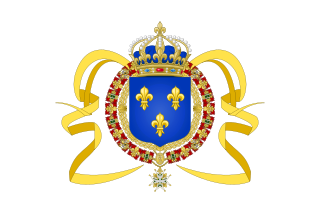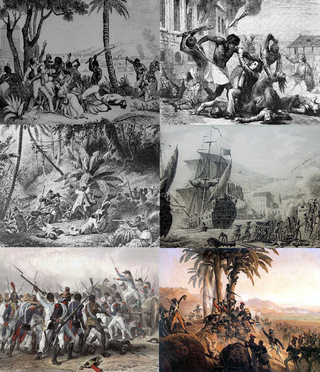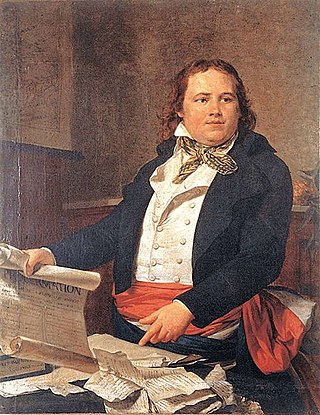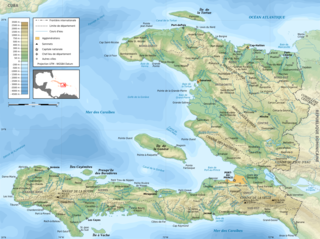Related Research Articles

François-Dominique Toussaint Louverture was a Haitian general and the most prominent leader of the Haitian Revolution. During his life, Louverture first fought against the French, then for them, and then finally against France again for the cause of Haitian independence. As a revolutionary leader, Louverture displayed military and political acumen that helped transform the fledgling slave rebellion into a revolutionary movement. Louverture is now known as the "Father of Haiti".

Jean-Jacques Dessalines was a leader of the Haitian Revolution and the first ruler of an independent Haiti under the 1805 constitution. Initially regarded as governor-general, Dessalines was later named Emperor of Haiti as Jacques I (1804–1806) by generals of the Haitian Revolution Army and ruled in that capacity until being assassinated in 1806. He has been referred to as the father of the nation of Haiti.

Saint-Domingue was a French colony in the western portion of the Caribbean island of Hispaniola, in the area of modern-day Haiti, from 1659 to 1804. The name derives from the Spanish main city on the island, Santo Domingo, which came to refer specifically to the Spanish-held Captaincy General of Santo Domingo, now the Dominican Republic. The borders between the two were fluid and changed over time until they were finally solidified in the Dominican War of Independence in 1844.

Alexandre Sabès Pétion was the first president of the Republic of Haiti from 1807 until his death in 1818. One of Haiti's founding fathers, Pétion belonged to the revolutionary quartet that also includes Toussaint Louverture, Jean-Jacques Dessalines, and his later rival Henri Christophe. Regarded as an excellent artilleryman in his early adulthood, Pétion would distinguish himself as an esteemed military commander with experience leading both French and Haitian troops. The 1802 coalition formed by him and Dessalines against French forces led by Charles Leclerc would prove to be a watershed moment in the decade-long conflict, eventually culminating in the decisive Haitian victory at the Battle of Vertières in 1803.

In the context of the history of slavery in the Americas, free people of color were primarily people of mixed African, European, and Native American descent who were not enslaved. However, the term also applied to people born free who were primarily of black African descent with little mixture. They were a distinct group of free people of color in the French colonies, including Louisiana and in settlements on Caribbean islands, such as Saint-Domingue (Haiti), St. Lucia, Dominica, Guadeloupe, and Martinique. In these territories and major cities, particularly New Orleans, and those cities held by the Spanish, a substantial third class of primarily mixed-race, free people developed. These colonial societies classified mixed-race people in a variety of ways, generally related to visible features and to the proportion of African ancestry. Racial classifications were numerous in Latin America.

The Haitian Revolution was a successful insurrection by self-liberated slaves against French colonial rule in Saint-Domingue, now the sovereign state of Haiti. The revolt began on 22 August 1791, and ended in 1804 with the former colony's independence. It involved black, biracial, French, Spanish, British, and Polish participants—with the ex-slave Toussaint Louverture emerging as Haiti's most prominent general. The revolution was the only slave uprising that led to the founding of a state which was both free from slavery and ruled by non-whites and former captives. It is now widely seen as a defining moment in the history of the Atlantic World.
Affranchi is a former French legal term denoting a freedman or emancipated slave, but was a term used to refer pejoratively to mulattoes. It is used in the English language to describe the social class of freedmen in Saint-Domingue, and other slave-holding French territories, who held legal rights intermediate between those of free whites and enslaved Africans. In Saint-Domingue, roughly half of the affranchis were gens de couleur libres and the other half African slaves.

Léger-Félicité Sonthonax was a French abolitionist and Jacobin before joining the Girondist party, which emerged in 1791. During the French Revolution, he controlled 7,000 French troops in Saint-Domingue during part of the Haitian Revolution. His official title was Civil Commissioner. From September 1792, he and Polverel became the de facto rulers of Saint-Domingue's non-slave population. Because they were associated with Brissot’s party, they were put in accusation by the convention on July 16, 1793, but a ship to bring them back in France didn’t arrive in the colony until June 1794, and they arrived in France in the time of the downfall of Robespierre. They had a fair trial in 1795 and were acquitted of the charges the white colonists brought against them. Sonthonax believed that Saint-Domingue's whites were royalists or separatists, so he attacked the military power of the white settlers and by doing so alienated the colonial settlers from their government. Many gens de couleur asserted that they could form the military backbone of Saint-Domingue if they were given rights, but Sonthonax rejected this view as outdated in the wake of the August 1791 slave uprising. He believed that Saint-Domingue would need ex-slave soldiers among the ranks of the colonial army if it was to survive. On August 1793, he proclaimed freedom for all slaves in the north province. His critics allege that he was forced into ending slavery in order to maintain his own power.
Julien Raimond was a Saint Dominican indigo planter in the French colony of Saint-Domingue, now the Republic of Haiti, who became a leader in its revolution and the formation of Haiti.

Vincent Ogé was a Dominican Creole revolutionary, merchant, military officer and goldsmith best known for his role in leading a failed uprising against French colonial rule in the colony of Saint-Domingue in 1790. A mixed-race member of the colonial elite, Ogé's revolt occurred just before the Haitian Revolution, which resulted in the colony's independence from France, and left a contested legacy in post-independence Haiti.
Plaçage was a recognized extralegal system in French and Spanish slave colonies of North America by which ethnic European men entered into civil unions with non-Europeans of African, Native American and mixed-race descent. The term comes from the French placer meaning "to place with". The women were not legally recognized as wives but were known as placées; their relationships were recognized among the free people of color as mariages de la main gauche or left-handed marriages. They became institutionalized with contracts or negotiations that settled property on the woman and her children and, in some cases, gave them freedom if they were enslaved. The system flourished throughout the French and Spanish colonial periods, reaching its zenith during the latter, between 1769 and 1803.

The Feast of All Saints is a historical novel by American author Anne Rice published in 1979 by Simon & Schuster.
The War of Knives, also known as the War of the South, was a civil war from June 1799 to July 1800 between the Haitian revolutionary Toussaint Louverture, a black ex-slave who controlled the north of Saint-Domingue, and his adversary André Rigaud, a mixed-race free person of color who controlled the south. Louverture and Rigaud fought over de facto control of the French colony of Saint-Domingue during the war. Their conflict followed the withdrawal of British forces from the colony earlier during the Haitian Revolution. The war resulted in Toussaint taking control of the entirety of Saint-Domingue, and Rigaud fleeing into exile.

Slavery in Haiti began after the arrival of Christopher Columbus on the island in 1492 with the European colonists that followed from Portugal, Spain and France. The practice was devastating to the native population. Following the indigenous Tainos' near decimation from forced labor, disease and war, the Spanish, under initial advisement of the Catholic priest Bartolomé de las Casas and with the blessing of the Catholic church, began engaging in earnest during the 17th century in the forced labor of enslaved Africans. During the French colonial period, beginning in 1625, the economy of Saint-Domingue, was based on slavery; conditions on Saint-Domingue became notoriously bad even compared to chattel slavery conditions elsewhere.
Elisabeth "Zabeau" Bellanton, was a French slave trader. She is known to have been the most successful business woman in the French colony of Saint Domingue prior to the Haitian Revolution.
Jean Kina, was a slave in the French colony of Saint Domingue who became a counterrevolutionary military leader in the Haitian Revolution and French Revolutionary Wars.
Rosette Rochon (1767–1863) was an American placée and businesswoman, who was an important figure in the Gens de couleur libres society of New Orleans. She belonged to the most famous of the placées of New Orleans alongside Eulalie de Mandéville and Marie Thérèse Metoyer, and made a fortune on investments in dry goods, cattle, banking, slave trade and real estate business.

The Le Jeune Case was a suit brought by 14 slaves against torture and murder by their master, Nicolas Le Jeune, in the French colony of Saint-Domingue in 1788. Le Jeune was accused of torturing and murdering six slaves, who he said had planned to poison him. Despite overwhelming evidence of Le Jeune's guilt, courts ruled in favor of the planter, demonstrating the complicity of Saint-Domingue's legal system in the brutalization of slaves. The Haitian Revolution ending slavery in Saint-Domingue would begin only three years later.

Saint Dominicans, or simply Dominicans, also known as Saint Dominguans, or Dominguans, are the people who lived in the French colony of Saint-Domingue before the Haitian Revolution. Dominican Creoles formed an ethnic group native to Saint-Domingue, they were all of the people who were born in Saint Domingue. The Creoles were well educated, and they created much art, such as the famed St. Dominican French Opera; their society prized manners, good breeding, tradition, and honor. During and after the Haitian Revolution, many St. Dominicans fled to locations in the United States, other Antilles islands, New York City, Cuba, France, Jamaica, and especially New Orleans in Louisiana, where they made an enormous impact on Louisiana Creole culture.